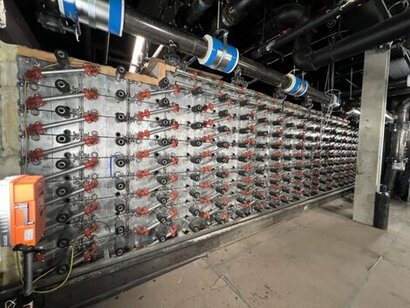
The award is presented to projects that utilise innovation and unique design to improve the state of practice of energy-related engineering in Los Angeles. Nostromo’s IceBrick Innovation Centre - encompassing a 1400 kWh energy storage installation- is open for visits by appointment.
As buildings move to become more sustainable, air conditioning remains a significant roadblock, constituting up to 70 percent of a building's peak energy load. In Los Angeles, air conditioning in commercial buildings accounts for approximately 35 percent of peak electricity demand, creating substantial strain on the urban energy grid and increasing reliance on fossil fuels.
Installed at the iconic Beverly Hilton, Nostromo’s carefully implemented project involved retrofitting the 69 year old building into a state-of-the-art Grid Interactive Asset, during which 300,000 pounds of IceBrick cells and supporting hydraulic and electric equipment were brought in through a 3-foot corridor and installed in a refurbished old boiler room.
The IceBrick system provides the Beverly Hilton with a solution that shifts energy consumption for cooling to off-peak hours, when solar energy is most prevalent, alleviating grid strain. It reduces the building’s energy consumption during peak hours, when solar energy is no longer used, by freezing 150,000 pounds of encapsulated water into ice during off-peak hours. The ice then cools the air conditioning’s circulating water during peak hours, eliminating the need for energy-intensive chillers to function at that time, and thus reducing strain on the grid. The system's use of off-peak energy reduces the hotel’s annual energy cooling costs by 50 percent and CO2 emissions by 150-200 metric tons annually.
“We are honoured to receive this award that recognises our commitment to paving the way for a more sustainable future in Los Angeles and beyond” said Yoram Ashery, CEO of Nostromo Energy. “We look forward to strengthening our partnership with the city’s commercial sector and working with additional properties, which together can significantly contribute to clean energy targets while simultaneously benefiting the cost-efficiency of commercial businesses.”
For additional information:

